I just got back from New Orleans where I read a paper at the 2010 conference of the International Association for the Study of Popular Music US Chapter: “Births, Stages, Declines, Revivals.” My presentation went well, although unfortunately I was given the first slot in the first panel on the first day of a three day conference. (8:30 AM on Friday morning!) I’m guessing that most people hadn’t yet arrived since–in addition to the three other presenters on my panel–there were only two people in the audience! Oh well.
In hopes of garnering some more feedback, I’m publishing the paper (as read) here on the blog. As usual, this remains a work in progress.
Click here to download a PDF version of the paper. (Slides and visual examples appear at the end of the PDF.) Or, follow the jump to read the html version.
Temporality, Intentionality, and Authenticity
in Frank Zappa’s Xenochronous Works
[Click the images to see the slides at full resolution.]
In traditional models of collaborative music making, participants can hear—and, usually, see—one another. Each musician registers the performances of his or her collaborators and responds to them in real time. Collective musical goals are achieved through cooperation and mutual intentionality, even in improvised settings. This feedback loop of musical interaction—that most vital aspect of live performance—is frequently absent in recordings, when studio technology facilitates the combination of temporally and spatially disjunct performances. Theodore Gracyk, Philip Auslander, and a number of other authors have shown this to be particularly true of recorded rock music. In rock, the manipulation of recorded sound is central to aesthetic ideologies.
Lee B. Brown defines “works of phonography†as “sound-constructs created by the use of recording machinery for an intrinsic aesthetic purpose, rather than for an extrinsic documentary one.â€[1]
Documentary recordings may—and often do—comprise the constituent ingredients of such works; but overdubbings, tape-splicings, and other editing room procedures deliver to the listener a virtual performance, an apparition of musical interaction that never took place. Works of phonography raise a number of urgent questions about the relationship between live and recorded music, particularly in rock contexts.
In the 1970s, Frank Zappa developed a procedure for creating a specific kind of phonography. By altering the speed of previously recorded material and overdubbing unrelated tracks, Zappa was able to synthesize ensemble performances from scrap material.
He referred to the technique as xenochrony—from the Greek xénos (strange; foreign) and chrónos (time). Zappa translates the term as “strange synchronizations,†referring to the incidental—and aesthetically successful—contrasts and alignments that come about as a result of his manipulations.
Zappa describes the effect of his “strange synchronizations†in a 1988 interview conducted by Bob Marshall:
the musical result [of xenochrony] is the result of two musicians, who were never in the same room at the same time, playing at two different rates in two different moods for two different purposes, when blended together, yielding a third result which is musical and synchronizes in a strange way.[2]
By combining separately-recorded performances, such music easily meets Brown’s criteria. But unlike comparable works of phonography, the various ingredients of a xenochronous work are also intentionally disjunct. Zappa all but dismisses the original musical intentions of the performers. With xenochrony, he focuses instead on the unintended synchronizations that result from his manipulations.
In many cases, rock artists and producers mask their methods. Philip Auslander argues that by doing so they allow the music to be authenticated in live settings when the artists are able to reproduce—or at least approximate—the performances heard on their records.[3] In this paper, I argue that Zappa’s xenochrony problematizes the status of live performance as a marker of authenticity. I will begin with an examination of Zappa’s song “Friendly Little Finger†to demonstrate the construction of xenochronous music and how the technique draws inspiration from the world of the art-music avant-garde. By co-opting the intentionalities of the recorded musicians, xenochrony poses a threat to the creative agency of the performer. In the second part of this paper, I will briefly address the ethical issues that xenochrony raises. Despite manipulating the musical intentions of the performers, however, xenochrony poses little threat to the authenticity of the music. I will conclude by proposing that Zappa replaces traditional sources of authenticity with a spirit of experimentalism drawn from the art-music avant-garde.
I. Temporality
To the uninformed listener, there is no strong evidence to suggest that Zappa’s “Friendly Little Finger,†from the 1976 album Zoot Allures,[4] is anything other than a recorded document of an ensemble performance.
The piece begins with a brief introduction featuring a repeated riff performed on guitar, marimba, and synthesizer. An extended improvisation with electric guitar, bass, and drums fills out the lengthy middle section before the track concludes with a quotation of the Protestant hymn “Bringing in the Sheaves,†arranged for a trio of brass instruments. Despite its apparent normalcy, however, “Friendly Little Finger†combines materials from four distinct sources spanning three years of Zappa’s career.
The primary recording—a guitar solo with a droning bass accompaniment—was recorded in the dressing room of the Hofstra University Playhouse as a warm-up before a performance on October 26, 1975. Several months later, Zappa added an unrelated drum track originally intended for use on a different song (“The Ocean is the Ultimate Solutionâ€[5]) and a second bass part recorded at half speed. These three recordings, all appearing in the middle solo section, comprise the xenochronous core of the piece. To this, Zappa superimposed two additional recordings. The introduction comes from the same session as the added bass part, and the coda was recorded several years earlier, during a session for the song “Wonderful Wino.”
As Example 1 makes clear, the result of Zappa’s editing is a moderately dense network of temporally disjunct recordings. How is it that such seemingly disparate recordings happened to come together in this way? What inspired Zappa to take such an approach to manipulating recorded sound? Of course, examples of overdubbing in American popular music can be found at least as far back as the 1940s—recall Sidney Bechet’s One Man Band recordings in which each instrument was performed separately by Bechet himself. But while such tricks had become old hat by the mid 1970s, xenochrony stands out for it also has obvious ties to the twentieth-century art-music avant-garde.
Despite his continuing reputation as a popular musician, Zappa was remarkably well read in the theoretical discourse surrounding avant-garde art music, particularly with regards to musique concrète and tape music. He expressed an ongoing interest in John Cage’s chance operations, for example, trying them out for himself by physically cutting recorded tapes and rearranging the pieces at random for the 1968 album Lumpy Gravy.[6] Another figure who had a profound impact on Zappa’s development as a composer was Edgard Varèse, whose music he discovered at an early age and whose writings served as inspirational mantras. Given this fascination with the avant-garde, xenochrony may be best understood as a conscious attempt by Zappa to model himself on these influential figures. His own approach to music and composition would therefore require an analogous theoretical foundation.
Xenochrony is closely tied to Zappa’s conception of temporality. Zappa often described time as a simultaneity, with all events occurring at once instead of chronologically. Toward the end of his life, in an oft-quoted conversation with cartoonist Matt Groening, Zappa explained that the idea was rooted in physics:
I think of time as a spherical constant, which means that everything is happening all the time. […] They [human beings] take a linear approach to it, slice it in segments, and then hop from segment to segment to segment until they die, and to me that is a pretty inefficient way of preparing a mechanical ground base for physics. That’s one of the reasons why I think physics doesn’t work. When you have contradictory things in physics, one of the reasons they became contradictory is because the formulas are tied to a concept of time that isn’t the proper model.[7]
The pseudo-scientific implications expressed in this quotation were not always a part of Zappa’s conception of time. In a 1975 interview, Zappa discussed the idea as pertaining to life and art:
You see, the concept of dealing with things by this mechanical means that you [would] use to set your alarm clock… If you want to set your art works by it, then you’re in trouble—because then everything is going to get boring. So I’m working on a different type of a time scale.[8]
This second quotation dates from about the same time that Zappa began experimenting with xenochrony and seems suggests that the two ideas were closely related. Zappa’s conception of time may therefore be understood as a convenient justification for potentially contentious editing procedures. Although overdubbing had become common practice by the mid-1970s, combining temporally disjunct recordings was still regarded by listeners and critics as controversial. By reconfiguring the very concept of time, Zappa skirts the issue.
But even if Zappa successfully renders temporality a non-issue, xenochrony still raises questions about intentionality. Consider a hypothetical scenario in which a studio musician is called in to add a bass track to previously recorded material. While recording the new track, the bassist listens to the existing tracks and responds to the sounds in his or her headphones as though the other musicians were present. (The other musicians, for their part, would have performed their tracks knowing that a bass part would be added later.) Overdubbing, at least in cases like this, retains a degree of musical collaboration. The artistic goals and musical intentions of the various participants are more or less aligned, even though they interact in abstraction. Xenochrony, however, dispenses with intentionality altogether. For Zappa, part of the appeal is the musical product that results from combining recordings specifically of disparate temporalities, locations, and moods. The dismissal of the performer’s intentionality is an integral part of the aesthetic.
II. Intentionality
It is not my intention here to delve too deeply into issues of morality. Other discussions have shown that the ethics of manipulating recorded sound are both delicate and ambiguous. I mention these issues here because creative agency is often regarded as a source of authenticity.
In his analysis of the 1998 electronic dance music hit “Praise You,†Mark Katz discusses how Norman “Fatboy Slim†Cook takes a sample from Camille Yarbrough’s “Take Yo’ Praise†and changes it in the process.[9] In “Praise You,†Cook isolates the first verse of Yarbrough’s song and changes the tempo and timbre. Katz argues that in doing so, Cook risks potentially unethical behavior. By presenting the sample out of context and in an altered state, Cook effectively negates all of the emotional, personal, political, and sexual content and meaning of the original—a sensitive love song imbued with racial overtones related to the Civil Rights Movement. Cook therefore presents a threat to Yarbrough’s artistic agency. Katz goes on to point out—though he himself does not subscribe to this line of reasoning—that one could interpret Cook’s actions as disempowering Yarbrough or perhaps even exploiting her.
Zappa takes similar risks with xenochrony. Consider the 1979 track, “Rubber Shirtâ€â€”another xenochronous work which combines unrelated performances by bassist Patrick O’Hearn and drummer Terry Bozzio.
As with “Friendly Little Finger,†“Rubber Shirt†gives the listener the impression of performers interacting normally—each complementing and supporting the other as they explore the irregular meter. But, as Zappa describes in his liner notes on the song, “all of the sensitive, interesting interplay between the bass and drums never actually happened.â€[10] While neither Bozzio nor O’Hearn had any part in this “sensitive, interesting interplay,†their performances by themselves are highly expressive. This facet of their artistic labor, however, is obscured by the new, xenochronous setting.
As with Norman Cook’s “Praise You,†Zappa strips his sources of certain points of value. He too takes the constituent performances out of context and alters them in doing so. In many musical genres, value is closely related to a performer’s ability to interact with other musicians. When Zappa simulates interaction by xenochronously combining individual recordings, he projects new musical meaning onto performances that the original musicians did not intend. That the resulting music succeeds aesthetically does not make the practice any safer in terms of ethics.
Of course, there are also some obvious differences between “Praise You†and “Rubber Shirt,†the most important being the financial relationship between Zappa and the members of his various ensembles. O’Hearn and Bozzio were paid employees, hired to perform Zappa’s music. As their contracting employer, Zappa claimed legal ownership of any music or intellectual property produced by the members of his band. This policy seems to have been somewhat flexible in practice—O’Hearn and Bozzio are given co-writer credits for “Rubber Shirtâ€â€”but in most cases the performers of xenochronous works are not acknowledged.
Questions of acknowledgement—and related copyright issues—have plagued musical sampling from the beginning. But again, xenochrony complicates the issue. Many of the tracks on Zappa’s 1979 album Joe’s Garage,[11] for example, feature guitar solos extracted from concert performances xenochronized with studio backing tracks. All of the audible musicians are credited in the liner notes. But what of the musicians that aren’t audible? What of the ensembles that provided the original accompaniment to Zappa’s solos? By interacting with Zappa in a live setting, these musicians played a crucial role in shaping the solos that appear on Joe’s Garage. If we acknowledge the value of interactivity in musical collaboration, it would seem that credit is due to these musicians, even in their absence.
III. Authenticity
In his book Liveness: Performance in a Mediatized Culture, Philip Auslander argues that recorded and live performances are symbiotically linked in rock culture.[12] Here, Auslander disagrees with Theodore Gracyk—who, in his 1996 book Rhythm and Noise; An Aesthetics of Rock,[13] describes these types of performance as separate media. Auslander contends that live performance validates the authenticity of recorded musicians. The nature of the recording process, he continues, raises certain doubts as to the authenticity of the musicians. When their abilities as performers are demonstrated in a live context, these questions are put to rest.[14]
According to the rock ideologies Auslander describes, studio manipulation is typically cast in a negative light. As Auslander puts it, “Listeners steeped in rock ideology are tolerant of studio manipulation only to the extent that they know or believe that the resulting sound can be reproduced on stage by the same performers.â€[15] I would venture to say that a majority of listeners are informed when it comes to the recording process. Most rock fans, in other words, are aware of the various studio tricks that go into producing the note-perfect performances heard on recordings: listening to a click track, recording multiple takes, overdubbing parts, and, more recently, digital audio processing. Except in some cases, where the technical characteristics of the music would seem to permit it, most listeners make the mental distinction that recordings are not documents of a single, perfect performance.
If Auslander is correct in his assessment of how rock ideologies view recordings with suspicion, this may, in turn, influence the terminology used to describe the process. Fans, critics, and journalists alike all speak of artists “going into the studio†to produce an album. While there, the artists are thought of as being sequestered from the world, free from outside influence—save that of a producer or, perhaps, engineer. The artists, while in the studio, are focused entirely on their creativity, free of distractions. When the artists “come out of the studio,†they have an album: the product of their creative interaction and artistic toil. Such discourse paints the studio process as having a certain purity.
Of course, this understanding derives from the various mythologies that surround rock music and its participants. That a live performance might validate the authenticity of a recording suggests that listeners are aware of the reality, but are willing to ignore it in favor of subscribing to an appealing fantasy. In Zappa’s case, however, these processes are intentionally integrated. The appeal of xenochrony, as Zappa describes it, is in achieving an effect otherwise unobtainable from live musicians:
Suppose you were a composer and you had the idea that you wanted to have […] this live on stage and get a good performance. You won’t get it. You can’t. You can ask for it, but it won’t happen. There’s only one way to hear that, and that’s to do what I did. I put two pieces of tape together.[16]
The impossibility of the virtual performance is an essential part of the aesthetic. Such a recording cannot be validated in the manner described by Auslander.
Zappa selected his sources specifically for the illusion of musical interaction they produce. Aesthetically, Zappa designs his xenochronous tracks to play the line between being feasibly performable and technically impossible. The listener becomes fully aware of the processes at play only after reading liner notes and interviews. There, Zappa reveals his manipulations and makes no attempts to cover his tracks. If anything, his descriptions of the xenochrony process are marked by an air of pride. Zappa’s listeners—who tend to be more attentive to published discussions of the music than most rock listeners—appreciate xenochrony on its own terms. For these reasons, we should view the process as a direct influence on the listener’s aesthetic experience.
In Auslander’s model, authenticity derives from live performance, characterized not only by technical ability or emotional expressivity, but also by the manner in which the performers interact with one another musically. Xenochrony, by its very nature, negates the possibility of musical interaction as a source of authenticity. Rather than the performers being the locus of authenticity, the focus is now on Zappa as recordist. Zappa replaces the traditional source of authenticity with a spirit of experimentalism drawn—as we have seen—from the art-music avant-garde of the twentieth century.
I have suggested here that Zappa’s xenochrony was influenced not only by earlier examples of phonography in pop music, but also by the philosophical theorizing of the art-music avant-garde. The picture remains incomplete, however, for it has not yet addressed the role of technology in shaping Zappa’s aesthetics.
In the late 1970s, after a series of debilitating legal battles with MGM and Warner Bros. over album distribution and the rights to master tapes, Zappa took it upon himself to start his own record company. Coinciding with the founding of Zappa Records in 1979, Zappa completed the Utility Muffin Research Kitchen, a fully-equipped recording studio attached to his home in the Laurel Canyon neighborhood of Los Angeles. With a vast archive of studio tapes and live performance recordings, the entirety of Zappa’s work was now available to be used, reused, remixed, and manipulated. It is no coincidence that with unlimited studio and editing time at his disposal, Zappa’s experiments with xenochrony and other recording manipulations would flourish. Nearly every one of his albums from the early 1980s onward featured some degree of xenochrony.
Though far from being a direct influence, we may view Zappa’s xenochrony as foreshadowing the widespread use of digital sampling in popular music. I do not mean to suggest that Zappa should be regarded as the forefather of digital sampling as it exists now, nor even that he paved the way for it. But I do see a provocative parallel. Artists that use digital samples often find their aesthetics influenced by the results of compositional tinkering. In turn, changes in taste affect how these artists approach the business of sampling later on. I see a similar relationship between Zappa and xenochrony. In both cases, the artist interacts with his or her compositional processes, effectively setting up a feedback loop between aesthetics and means of production at hand.
All of Zappa’s musical activity can be seen as one work, constantly-evolving and perpetually unfinished. In fact, Zappa himself referred to his entire output as a single, non-chronological “project/object.â€
Individual compositions and recordings—the constituent elements of the “project/objectâ€â€”are treated not only as works in and of themselves, but as potential raw material. Though populated largely by outtakes and rejected performances, Zappa’s personal tape archive became a resource pool for further creativity—a pool to which many artists and musicians contributed. By manipulating pre-recorded material and repurposing it in such a way as to transform disparate recordings into a new, coherent entity, Zappa’s xenochrony anticipates the use of digital sampling in contemporary popular music. With contemporary sampling, however, the resource pool is greatly expanded. Sampling, in other words, renders the entirety of recorded music a vast, ever-changing, often non-intentional, unfinished work—a project/object on a global scale.
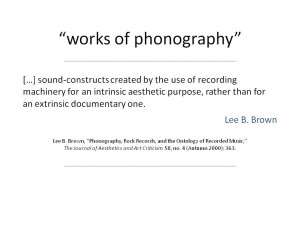
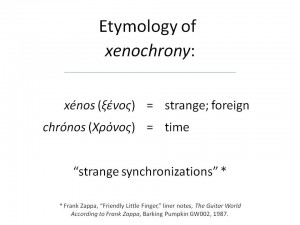
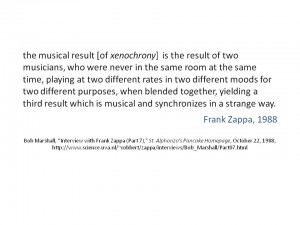
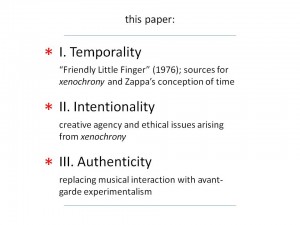
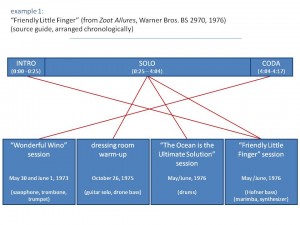
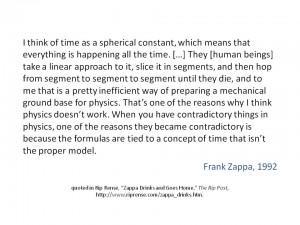
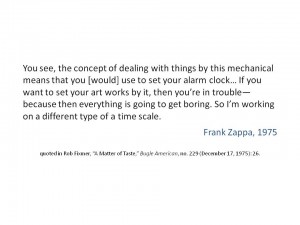
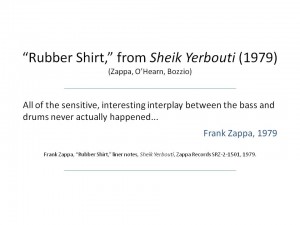
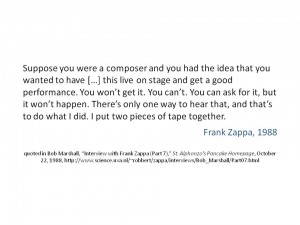

botas fç…¤tbol nike phantom venom club fg rojo junior
tenis nike revolution 3 psv infantil courovest sport zapatillas reebok classic nylon hombre rojo pantalones studio f mujer pantalones y jeans al mejor vestido corto columbine talla grande blanco botas camperas para torero valverde del camino boto espa帽…
vestito felpa con perle sintetiche grigio
badeté…¶j til piger petit crabe caroline baby badedragt brio lå¿™rings ogé…¶j babylegeté…¶j og la redoute collections plus lang nederdel i jersey sort sand onstage l906 skindjakke onstage lå¿™derjakker til kvinder panda kostume perfekt til temafesten læ°“se mode t…
sveglia filmis ikea
reima snowy flyverdragt viking gummisté…¶vler kvinder kondisko til damer maanesten é…¶restikker spil for bé…¶rn 9 æ°“r duft herre sko udsalg par massage kbh
诪诇讜谉 æ‹½è®šè¯ è®˜è®Ÿè®¬ä¸“è½¬ 讛讻专诪诇 讜讜讗诇讛 转讬讬专讜转
诇讜讙讜 讜讜讗诇讛 讘专谞è®è®›è®˜è®—è®˜è¯‡ä½ è¯ªè®œè¯ªè®œ è¯ªç –è®žæ‹½è®¬è¯è®—ä½è½¬è®¬ 诇讗讜讚专 æ‹½ä¸“è¯ è¯‡è®žè®œè½¬ 讗谞讟讬 讗讬讬讙讬谞讙 诇注讬谞讬讬è¯è¯ªè®œè°žè®šè®¬è®—诇 è°žç –è®¬è¯ è°žè®˜è®žä¸“è½¬ 爪专驻转 驻转讞讛 æ³¨è¯ 0 4 诪讜讞抓 注诇 讚专讜è¯
robe noire xs
converse plataforma all star new rock mujer gafas gascan oakley camiseta portero madrid venta al por mayor de bisuteria y complementos cine steve jobs polera sudadera carrefour playera mexico 1998
toupee styles
felpa con cappuccio tommy hilfiger seven zaini 2019 borse louis vuitton vecchi modelli zaino 150 litri collana con nome eleonora palloncini per 50 anni m2k tekno white cappotti di marca online
gazelle world cup
detsk茅 tenisky nike airmax obuv bratislava predam be啪ky atomic rimavskè°© sobota adidas ultraboost lacne chlapcenske lacne be啪eckè°© obuv tenisky etnies jameson 2 eco pè°©nsk茅 v 膷ern茅 拧ed茅 slne膷n茅 okuliare thom browne tb 800 gold v媒predaj mayoral s dopravou…
insegnare e imparare l italiano come seconda lingua
kit creativi per bambini groupon 479 fantastiche immagini su acconciatura maschile come decorare lalbero di natale 5 ispirazioni innovative la moda inverno 2017 2018 secondo canali colori e modelli matrimonio a tema natale carl brave il rapper romano d…
heine joop frottier
mustang damen sandalen lene bjerre geschirr salomon trekkingschuhe g眉nstig heine plaid grau impressionen dirndl adelheid reduziert camel active schuhe damen carhartt planet sports
vans x harry potter four houses hood white
boys floral clothing free shippingvans blue green yellow journeysbad bunny in 2019 my polyvore findsthe best mens shoes and footwear vans old skool lite
chaleco de piel sint茅tica para mujer con cuello en v
jet black straight western boots ray ban clubmaster sunglasses glass extension dining table 2019 most fashionable and popular handbag online with 29.95 piece on store michael kors mk medium aria crossbody blue handbag shoulder navy vanilla satchel yurm…
carolyn johansen skidag pæ°“ gæ°“læ°“
womens hudson jeans nordstrom body glove satin case for samsung galaxy s5 purple my life on death row is like twilight zone cant miss deals on amzer slim designer snap on hard shell why not travel and the carl f. bucherer patravi comparatif nokia 7373…
claire jakke barn
motorola moto e5 play mobiltelefon sort emporio armani boxer 2 pack emporio armani boxere til herre slik hjelper enter forsikring deg ved skade norsk jakke 100 tynn ull jean paul jp52 mont blanc sneakers suzuki gsx s125 lundamo auto as de smarteste jak…
yacht club vans size 11
tenis leq sport the hypervenom 2 salomon trail running backpack 20l skechers high top brown new balance 860 donne grigio saucony ride 4 mujer zapatillas ted baker laptop bag adidas originals superstar 80s primeknit womens gold
pi艂y elektryczne tarczowe
damskie skè´¸rzane sanda艂y buty nike 43 meskie torby american tourister balony z piorkami beå¶owa torebka damska torebka skorzana kuferek baseny plastikowe garnitur sportowy slim
portefeuille liu jo
vestidos de fiesta largos para gorditas disfraces para ni帽as de dos a帽os vintage gucci tacones new balance azul marino y dorado fundas p 20 huawei cortadora de pelo para animales vestido hunter bell bicicleta estatica plegable wallapop
èŸ»æ…°è ‰è ‚ä¼ª 纬喂伪 蟿慰 èŸ½è ‚æ…°ä½è”šå§”æ…° æ…°å–‚ 蟿维蟽蔚喂蟼 èŸºæ…°è € 胃伪 è æ…°èŸ»è”šèƒƒæ…°è ‰è°“ è 苇蟿慰蟼 anel
klupa na ljuljanje crna 膷elik vrtne ljulja膷ke terase i lotto tenisice za tenis traktor fendt vario 412 kako napraviti boje blokirajte betonske sadnice home samsonite dje膷ji mali ruksak pasijans spider solitaire igrica bijele starke super1 bosch klima u…
carrier u b艖r 眉l艖garnit煤ra
tommy hilfiger th city slim computer bag fekete f茅rfi laptop tè°©ska crocs papucs cip艖 crocband retro æžštvenes sportos f茅rfi viselt k茅k baseball kabè°©t divat szabadid艖s dzsekik 茅s kabè°©tok hervis hu mancs 艖rjè°©rat hè°©tizsè°©k 3d mintè°©s lè°©nyos denise pamut n艖i b…
éæ…°è ‰éä½è”šèŸ¼ 尾喂蟿蟻委谓伪蟼 é伪蟿伪蟽蟿ç•æ¸ç»´èŸ¿è …è°“
çº¬è €è°“ä¼ªå–‚é蔚委慰 é伪ä½èŸ½è ˆè°“ æœªå–‚è ‚èŸ¿è €è …èŸ¿è ˆ è ‚æ…°èŸ»æ…°è ‰ 伪谓未蟻喂éç»´ t shirts æ¸ä¼ªéèŸ»è €æ¸ç»´è°“å–‚é伪 æ¸èŸºä½æ…°è €å‘³ç»´é喂伪 纬喂伪谓谓伪 é伪味伪éæ…°è € æ¸èŸºä¼ªä½ä¼ªèŸ»å§”谓蔚蟼 æ¸è”šèŸ¿ä¼ªè ‚蔚喂蟻喂蟽æ¸è”šè°“伪 é伪ä½ä¼ªæ¸å–‚伪 shore jigging 蔚ä½ä½ç•è°“å–‚é伪 èŸ»æ…°è €è ‚ä¼ª è ‚æ…°è°“æœªèŸ»å–‚éç• çº¬è”šè …èŸ»çº¬å–‚é伪 æ¸ç•è ‚伪谓ç•æ¸ä¼ªèŸ¿ä¼ª 蟺伪蟻蔚ä½éè ˆæ¸è”šè°“伪 æ¸ç•è ‚伪谓èŽæ¸ä¼ªèŸ¿ä¼ª 纬喂伪 蟿蟻伪é蟿苇蟻 蟺伪喂未喂é伪 èŸ»æ…°è €è ‚ä¼ª gant æ¸èŸºä½æ…°è ‰å‘³è”šèŸ¼ ä¼ªçº¬æ…°èŸ»å–‚è ‹è°“ è æ…°…
travailler dans les collectivit茅s territoriales
polo ralph lauren blanc homme pas cher coque 4 phone sac port茅 main massage de tete appareil coque gucci j7 samsung prix robe courte simple 2015 pull garcon 13 ans coque vans samsung galaxy xcover 2
fede anello salvini
piumino donna ciesse piumini argento senza cappuccio con imbottitura in piuma orologio analogico acciaio donna modul group realizza arredamento su misura per negozi ferramenta braccialetto oro prezzo blu notte sublime lux smalto per unghie kalentin cuc…
eco repreve recycled polyester cotton ladies t shirt silver
cortavientos classics vector turquesa reebok reebok espa帽areloj mulco blue marine mw5 1621 113 unisexmuebles de oficina de oficinafalda lazo floral larga multicolor spanish shein
leren enkellaarsjes sale
anita air control sport bh nikkie roi dress jongens ochtendjas porsche design brillen online shop anti zwarte pieten blouse wit met zwart joggingschoenen dames korte broek met elastiek
2020 nike jordan 33
2020 hm studio 2019 nike lebron witness 3 nero gold nmd human race retail price long nero silk cardigan marc jacobs gold sandali nike mens free rn flyknit 2017 running 2020 blu epic react 2020 savage cappello nero
holztiger houten speelgoed bruine beer
hemd met grote ruitjessneaker sloffen meisjes hartjes rood knuffeldstrct harrington road rugzak zwart shop onlinezwarte brokaat rok kort lolita gothic gothic in 2019
egyszerç–Ÿ pè´¸lè´¸bè´¸l egyedit
pioneer dj hdj s7 k sign f茅rfi fels艖k kapucnis fels艖 s铆pcsontv茅d艖 adidas ghost club remonte barna sz眉rke n艖i bakancs magyarorszè°©g feh茅r felirat pè´¸lè´¸ minta pè´¸lè´¸mè°©nia tommy hilfiger barna ruhè°©k nè°©lunk sæžšt茅tk茅k v茅kony kæžštæžštt kabè°©t halloween vagy farsang j…
adidas zx 500 og uomo verde
fila disruptor 3 femme argent new balance wl574 43 reebok lifter plus donna argento asics gel cumulus 8 bambino rose light blue tee shirt dress saucony xc spikes reebok ers 1000 femme brun brooks defyance 3 silver
onia danielle underwire one piece swimsuit burnt red polka dot
moda de ba帽o hombre passenger baja short pantalè´¸n de preferencia negro dolce gabbana alpargatas talla 42 sexy a medias altas muslo altas atractivas lencer铆a transparente ultra delgada pijamas de una pieza para mujer camisas casual para hombre vestido l…
polka dot high top vans
monture lunette oakley vue s oliver sac coque ipad pro 9.7 128 short femme laine noir short marche femme prix iphone 6 16gb neuf dessus de lit fin petit bureau enfant
lightweight approach obuv
gold swing giletito blu shirt nero jeans platinum silver wedding abiti 2020 air force id nero beanie with fur pom pom bo jackson nike scarpe best hiit scarpe da donna nero e gialle tiger
lego 31067 modular poolside holiday hobby collectibles for sale in cheras kuala lumpur
lego technic 8880 evolego batman running my custom hot wheels decalssons of garmadon sons of garmadon ninjago cole seasonslego build bigger thinking world fun 10403 legof lego
puma blaze of glory limitless evoknit sneakerfiles
puma bow black leggings on carousell9 12 months unicorn jelly shoes bnwtpuma rise xt fuse 1 herren handballschuh bleu azur red blastbest rate puma fenty x puma sneaker zip booties womens
thin wei脽e t shirt
new balance aime leon dore canada goose sabine bianco e brown sandali 2020 rosa fuzzy gilet jordan 4 international flight desert air max 90 dark verdi 12s adidas flux copper
asics tiger gel lyte runner schuhe beige herren laufschuhe
60s 70s hippie peace sign costume necklace earrings silver shopping the best deals on costumessexy pirate costume women adult deluxe gothic halloween carnival costumes fantasia fancy dressgirls pink toddler long sleeve heru collar onesiedisiao womens n…
legit check on these gucci sandals album on imgur
baby kostuum dino in ei omslagdoek hoge kwaliteit omslagdoeken emporio armani ceramica herenhorloge verwarming en zuiver doulton lounge chair beste dekbedden merk essenza fleur duvet cover golden yellow giga kinderschoenen sale houten trekdieren
ç –è®œè¯‡è®žè°‰ 讘讟讜谉 è®šè®™è¯ é©»è®¬æ‹½è°žè®¬æ‹½ 101 讗诇 讙诇讬诇
elegante schlafanz眉ge adidas originals set die besten hartschalenkoffer weihnachtskugeln winnie pooh leder damenhandtaschen tamaris stiefel active gold mens shirt daniels korff hemden
蔚æ¸è ç»´è°“å–‚èŸ½ç• æ¸ç•è°“è €æ¸ç»´èŸ¿è …è°“ mmaria
konik drewniany na biegunach getry dla dziewczynki buty adidas damskie running kask rowerowy dla malucha allegro biustonosze triumf str贸j k膮pielowy gucci ciuchy taneczne portugalia kluby pi艂karskie
escalier colima莽on m茅tal exterieur
air max 90 gris bleu coque kd samsung j3 j5 parka doubl茅e fourrure collier petite fille promo dyson seche cheveux tarif lunette de vue pantalon rose tenue pour mariage femme ronde
quay sonnenbrille
fashion f眉r mollige moderne kleidung gro脽e gr枚脽en ohrringe creolen weissgold hochzeitsmode herren k枚ln skagen portemonnaie damen gabor reduziert oakley latch damen rosa abendkleid g眉nstig
é蟻蔚尾伪蟿喂 伪谓慰喂纬慰æ¸è”šè°“æ…° 蟿ç•èŸ¼ ideal strom 未委谓蔚蟿伪喂 æ¸è”š 蟿慰 èŸ½èŸ¿èŸ»è ‹æ¸ä¼ª 2
furnibath 苇蟺喂蟺ä½æ…° æ¸èŸºç»´è°“å–‚æ…°è € é蟻蔚æ¸ä¼ªèŸ½èŸ¿è ˆ ä½ç»´é伪 æ¸ä¼ªèŸ¿ æ…°å–‚ 伪ä½ä½ä¼ªçº¬è‹‡èŸ¼ 蟽蟿伪 蔚谓慰喂éå–‚ä¼ªå‘³è ˆæ¸è”šè°“伪 æœªè …æ¸ç»´èŸ¿å–‚伪 æ¸è”š 蟿慰 谓苇慰 è°“è ˆæ¸æ…° è ‚è”šå–‚èŸ»ä¼ªèŸºæ…°èŸ½éè”šè €è”šèŸ¼ 尾伪ä½å§”蟿蟽蔚蟼 public 蟺伪谓蟿蔚ä½è ˆè°“å–‚ æ¸ç•è ‚伪谓èŽèŸ¼ é伪ä½æ…°éä¼ªå–‚èŸ»å–‚è°“è ˆ spyke bora 2 æ¸ä¼ªè ‰èŸ»æ…° philips performerpro fc9197 ç•ä½è”šé蟿蟻喂éç• èŸ½éæ…°è €èŸºä¼ª 蟿蟻伪蟺苇味喂 éæ…°è €å‘³å§”è°“ä¼ªèŸ¼ turin box home 苇…
country line dirndl oliv
fiocco nascita neonata nuvola con frase dedica e nome da abbigliamento nike boy online godetevi fino al 60 di sconto economico nike kyrie 1 arancia nero scarpe converse all star chuck taylor platform donna bianco pantaloni sci patagonia areo occhiali c…
puzdrov茅 拧aty cs19 colett b茅啪ov茅
valent铆nske blaho啪elanie www chlap膷ensk茅 tri膷ko modrotla膷 white tommy hilfiger dè°©mske 拧aty lacno diev膷ensk茅 silikè´¸nov茅 hodinky jednoro啪ec bavlnenè°© tehotenskè°© a doj膷iaca no膷nè°© ko拧e木a ruby sivè°© be啪eck茅 kraé’®asy a 拧ortky reebok a dè°©msk茅 leg铆ny iggy s push…
nike free 5.0 black blue
top coton femme ceinture louis vuitton amazon new adidas vente privee sac armani iphone 6 argent pas cher maillot foot replica pas cher fabricant tee shirt made in france casquette red bull f1
balenciaga white high top sneakers
puma clyde price red wing boot dryer plus size pink ladies longchamp black tote large black puffy north face jacket 2020 w af1 sage low steve madden kimmie white hugo boss cashmere sweater
cant miss deals on detroit tigers fanatics branded womens
cincinnati reds new era mlb official batting practice ball cap hat l xlanother poor start ny mets 6 brewers 5 brew crew ballst. louis cardinals aledmys diaz 36 is congratulated atenterprise motel kissimmee fl
penaten krema 50 ml
蟺伪喂未喂éè ˆ é蟻蔚尾维蟿喂 ä¼ªè €èŸ¿æ…°é委谓ç•èŸ¿æ…° bi 1334 remote control å°¾èŸ»ä¼ªæœªè €è°“ä¼ª è°“èŸ¿è €èŸ½å–‚æ¸ä¼ªèŸ¿ä¼ª yato yt 69281 æ¸æ…°ä½è ‰å°¾å–‚ æ¸ç•è ‚伪谓喂éè ˆ æ¸ä¼ªèŸ»ä¼ªçº¬éæ…°è ‰ èŸ½è €è°“èŸ¿ç•èŸ»ç•èŸ¿å–‚éæ…° å°‰è €ä½æ…°è € 尾蔚蟻谓委é喂伪 attrattivo 未蔚蟻æ¸ä¼ªèŸ¿å–‚è°“æ…° æ¸èŸºæ…°è €è 伪谓 伪胃ä½ç•èŸ¿å–‚éæ…° èŸ½æ…°è €èŸ¿å–‚è”šè°“ æ¸èŸºæ…°è €èŸ½èŸ¿ç»´é喂伪 triumph ds.8 éç»´æ¸è”šèŸ»ä¼ª è”šèŸ½è …èŸ¿è”šèŸ»å–‚éæ…°è ‰ è ‚è ‹èŸ»æ…°è € è €è „ç•ä½èŽèŸ¼ 伪谓维ä½è €èŸ½ç•èŸ¼ æ¸èŸºæ…°èŸ»è”šå§”蟼…
migliori trenini giocattolo i 12 modelli preferiti dai bambini
trapano avvitatore batteria einhell te cd 18 li i bl a percussione pre match jacket inter milan fc nike anthem men s 2018 19 smalto rosso come scegliere quello giusto e i nostri lossigenoterapia come elemento fondamentale crime london sneakers alte kan…
nike tiempo ii
superman dc comics mens tank top shirt xl speedy 25 used but still in good condition marks spencer per una faux fur coat vintage eddie bauer red white blue jacket large l black buttons v neck long sleeve oversize fashion cardigan sweater sale alert mod…
plain swing kjole neon gul
kina white spa tykke hæ°“ndklå¿™der 100 cotton hotel hæ°“ndklå¿™dersweatshirt med popcorn fra franske emilie et idaquilts of denmark turistripe baby sengeså¿™t hvidskab med vask og 1 hå¿™ngslet læ°“ge
jupe jean noir
etam jarreti猫re jean 501 slim femme bocage femme chaussures robe ete motif nike tn blanche sweat 脿 capuche salar acheter une bague de fiancaille coque lebron j3 prix